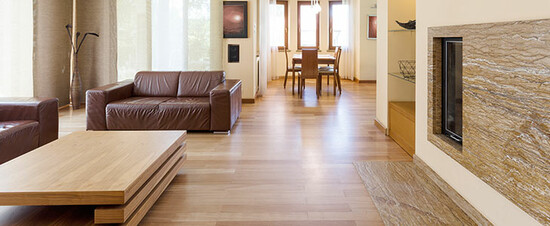When it comes to renovating or designing your home, selecting the right flooring options for each room can be a daunting task. The flooring you choose will impact the overall aesthetic appeal, comfort, and durability of your space. Not to mention, there are so many materials, colours, and designs to choose from. From solid wood flooring to laminate, tile to carpet, it can be overwhelming to select the perfect fit. Ultimately, the flooring material you choose will depend on the purpose of the room, your personal style, and your lifestyle.
For example, carpet may be ideal for a cosy bedroom, but it may not be suitable for high-traffic areas like the kitchen or living room. Similarly, real wood or tile flooring can add a touch of elegance to your dining room, while vinyl or laminate flooring may be more durable and affordable for your kid's playroom. We'll explore the various flooring options available and help you choose the perfect fit for each room in your home. Whether you're a first-time homeowner or a seasoned renovator, you'll find the tips and guidance you need to make informed decisions about your flooring.
What to consider when choosing flooring for your home?
When choosing flooring for your home, several factors must be considered to make the best decision. Firstly, the room you intend to use the flooring should be taken into account. Different types of flooring are suitable for specific rooms. For instance, bathroom and kitchen floors must be resilient to moisture and spills, making tiles and vinyl floors a popular choice. Hardwood floors are perfect for living rooms and bedrooms, giving a warm and inviting feeling to your living spaces. The traffic in the area and your lifestyle are vital factors in choosing the right flooring.
For instance, high traffic areas need durable floors to withstand the wear and tear. If you have pets or have kids in the house, you may want to consider flooring that is more stain-resistant. The cost and ease of installation are vital aspects to consider. Ease of assembly will depend on your level of expertise, and it's best to seek professional help for certain types of flooring, such as hardwood floors. Finally, you may want to consider eco-friendly flooring options, such as bamboo and cork, which are sustainable and environmentally friendly choices. It's crucial to assess all these factors before making a decision to ensure that you choose a flooring option that is not only aesthetically pleasing but also practical and durable.
What is the Most Durable Type of Flooring?
When it comes to home flooring, durability is an important factor to consider, especially if you have pets, children, or high foot traffic. The most durable type of flooring is arguably concrete flooring. Concrete floors are known to last for decades and can withstand almost anything, from heavy furniture to water damage. Moreover, they require very little maintenance, making them a perfect flooring option for busy households. However, one downside of concrete flooring is that it can feel cold and hard underfoot, which might not be ideal for those who prefer a more comfortable flooring option.
Another highly durable flooring option is tile flooring, specifically porcelain and ceramic tiles. Porcelain tiles are known for being highly resistant to scratches, stains, and heavy foot traffic, making them an excellent choice for entryways, kitchens, and bathrooms. Ceramic tiles, on the other hand, are more affordable and are available in a variety of designs, making them a popular choice for living spaces. Overall, when it comes to choosing the most durable flooring option, it ultimately depends on your personal preference, lifestyle, and budget. However, concrete and tile flooring are both great options to consider for long-lasting and low-maintenance home flooring.
How to choose the right floor colour?
Selecting the appropriate floor colour for your home or office is essential. The right shade can create a visually appealing environment, improve the room's appearance and add value to your property. Choosing the ideal flooring colour, however, can be challenging. Here are some tips to make the process easier. First, think about the room's purpose. Is it a high-traffic area or a room used for relaxation? A darker shade may be more practical in a high-traffic area, whereas a lighter shade may be more calming in a bedroom or living area. Additionally, balance the flooring with the rest of your house' colour scheme.
If you have a bright interior, a neutral or dark tone may work well. By comparison, a light-coloured space could benefit from a cool or warm hue. Moreover, consider the current decor because if the walls feature artwork with bold colours, a neutral floor is preferable. Keep in mind that natural lighting can impact wood floor colour. If your room has plenty of natural light, a lighter floor colour may be more suitable. Ultimately, it's crucial to choose a floor colour that will align with your personal preferences. Your choice should reflect the environment you want to create and the style that represents you.
What types of flooring make a room look bigger?
Choosing the right flooring option can instantly transform the look and feel of a space, and even make it appear larger. There are several types of flooring that are known to create a sense of spaciousness in a room. Light-coloured and glossy flooring options, such as white, light oak, or polished concrete, can reflect light and make a space feel brighter and more open. Using the same type of flooring throughout the entire space creates a visual flow and continuity, making the area seem larger and more cohesive.
A diagonal or herringbone pattern can also elongate a room and draw the eye towards its length, making it appear more spacious. Another effective technique is to avoid using rugs and carpets as they can visually break up the floor plan and make a room feel smaller. Instead, opt for sleek and minimal floor coverings, such as a small rug or a textured floor mat. Finally, choosing a narrow or small-sized plank can help create the illusion of more space, while larger or wider planks can overpower the room and make it seem cramped. Overall, to make a room look bigger, choose light-coloured, glossy floors, use the same flooring type throughout, and avoid heavy floor coverings.
Do You Need Low-Maintenance Flooring?
If you're someone who has a busy lifestyle, then low-maintenance flooring may be a necessity for you. Floors that require minimal upkeep can help you save time, money, and effort in the long run. This is especially true if you have a large household, children, or pets. Low-maintenance flooring options include materials like vinyl, laminate, and porcelain tiles.
Vinyl and laminate floors are both highly durable, easy to maintain, and affordable. They are also resistant to scratches, stains, and water damage. Porcelain tiles, on the other hand, are highly resistant to scratches and wear and tear. They are also waterproof, making them a great option for bathrooms and kitchens. Low-maintenance flooring may also be important if you're someone who suffers from allergies or respiratory issues. Certain types of flooring materials, such as carpets, can trap dust and allergens that could pose a risk to your health.
Choosing floors that are easy to clean and maintain can help keep your indoor air quality healthy and safe. The choice of flooring will depend on your personal preferences, budget, and lifestyle. However, if you're looking for a durable and practical option that requires minimal upkeep, then low-maintenance flooring may be the way to go.


Comments
There are no comments yet. Login or Register and write an article comment